Jan's Working with Presentations
Appendix: Glossary
If you don't see the term you are looking for, use your browser's Find command to search for it. Perhaps your term is used in a definition.
Each term is linked back to the appropriate lesson. If you don't see the term on that page, use your browser's Find command to search for it.
# or symbol
A B C D E F G H I J K L M N O P Q R S T U V W X Y Z
# or Symbol
A
- Action


 PowerPoint 2010, 2013, 2016: An additional action that you
can take on an object. Formerly called Smart Tag.
PowerPoint 2010, 2013, 2016: An additional action that you
can take on an object. Formerly called Smart Tag.- align objects
- To line up objects like placeholders, text boxes, shapes, images, tables, and charts with respect to each other - left edges, right edges, centered over each other, top edges, bottom edges, centered horizontally.
- animation
- An effect applied to part of a slide controlling the entrance, emphasis, exit, or motion path of that part.
- aspect ratio
- The ratio of the width to the height of a shape or object. Usually expressed as two numbers separated by a colon, like 4:3 or 16:9.
-
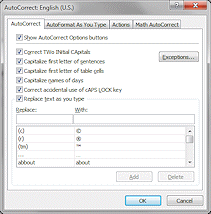 AutoCorrect dialog
AutoCorrect dialog - Dialog which allows you to control what kinds of corrections Microsoft Office programs will make automatically, such as inserting the copyright symbol when you type (c) or substituting the company's full name when you type its initials.
- The AutoFormat As You Type tab controls a number of formatting changes that Microsoft Office programs make, such as changing "straight quotes" to "smart quotes" and changing 1/2 to ½. It also includes AutoFit for title and body text placeholders and automatic formatting for bullet lists.
- AutoCorrect Options
- When Microsoft Office programs make an automatic
correction, the AutoCorrect Options button allows you
to keep or discard the correction. It first appears as
a small rectangle under the correction.
 It does not appear until the mouse pointer is near the
corrected text. Hovering over the rectangle makes the
full button appear.
It does not appear until the mouse pointer is near the
corrected text. Hovering over the rectangle makes the
full button appear.

-
 Clicking
the down arrow opens a list of your options, which
varies depending on what the change was.
Clicking
the down arrow opens a list of your options, which
varies depending on what the change was.
- AutoFit Options
-
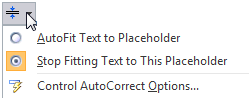 The
AutoFit Options button
The
AutoFit Options button
 appears when PowerPoint changes the size of your text
to make all the text fit into the placeholder.
Clicking the button opens a list of options.
appears when PowerPoint changes the size of your text
to make all the text fit into the placeholder.
Clicking the button opens a list of options.
- AutoPreview
- Allows the Slide Pane to play an effect as soon as you select it.
- axis
- The X-axis is the horizontal base line for a chart. The Y-axis is the vertical base line for a chart.
B
- bitmap image
- An image which defines the color of each pixel in the image.
- build
- To build a slide is to reveal its parts in stages.
C
- cell
- The intersection of a row and a column in a table.
- chart
- A picture of data showing how values compare to each other (commonly with a Column chart) or how they compare to the whole (Pie chart).
- clip art
- Images which have been made available for people to insert into documents. These were originally drawings but now photos are included in most such collections.
- collate
- When printing several copies of a document, collating the pages makes the printer print all of the pages in order before starting on the next copy. Not collating will print all copies of page 1 before starting on page 2.
- color theme
- A set of colors for Office documents.
- column
- Table: a vertical set of cells
Chart: a single data item in the shape of a vertical rectangle or 3-D column - column label
- Cell at the top of a data table that identifies what that column is, like Date or Location or Cost.
- Compatibility Mode
- Opens older Office files in a newer version of an Office program and disables newer features that the older versions cannot handle. This enables you to work on older files in newer versions of Office programs but still allow older versions to view and edit the files.
- content template
- A design template for a presentation that includes sample slides with suggestions for what information to include. Only when used to create a new presentation will the sample slides appear.
- Convert
- Changes the embedded object to a different type. Normally used to convert a non-Office file type to the matching Office file type, like changing a word processing document into Word format.
- copyright
- The legal ownership with the right to control how a document or image is used.
- Custom animation
- Animation that you have chosen and modified for selected slide parts.
- custom template
- A presentation template that you created yourself or have modified and saved as a .potx file.
D
- data range
- The set of cells used for a chart
- datasheet
- The table of data values used to create a chart.
- Decrease List Level
 Used in outlines and bullet text to change the
outline level of a paragraph. Normally this also changes the
bullet symbol and formatting. This is the same as promoting
the paragraph since #1 is the highest list level for outlines.
Used in outlines and bullet text to change the
outline level of a paragraph. Normally this also changes the
bullet symbol and formatting. This is the same as promoting
the paragraph since #1 is the highest list level for outlines.- default
- What happens unless you have changed the setting or make a specific choice.
- demote
- To change the outline level of text in an outline hierarchy to a lower level number, like changing a paragraph with outline level 3 to outline level 2. This actually makes the paragraph more important in the outline.
- design template
- A set of Masters that control the placeholders, background, and text formatting of the slides. A Slide Master can also contain transitions and animations. The Notes Master and Handouts Master control print-outs.
E
- effect
- A transition for a slide or an animation for part of a slide.
- embed
- fonts: To include the fonts used in a package of files to transport a presentation to a different computer.
- objects: To insert an object onto a slide, like a chart or spreadsheet, from another program without linking the object to the original. Changes to the original will not show on the slide. Changes to the object on the slide will not show in the original.
- Emphasis
- A change in a slide part that draws attention to it after it is revealed. Examples: change of color, change of size, blinking, spinning
- Entrance
- How a slide part is revealed
- Exit
- How a slide part leaves the screen
F
- file extension
- The part of a file's name that follows the dot, like mypresentation.pptx or myimage.gif.
- file format
- See file type.
- file name
- The full name you see in an Explorer window for the file, such as worldtraveloffer.pptx. To see the extension the Computer/Explorer/File Explorer window must be set to show the file extensions in the Folder Options or View ribbon tab.
-

- file type
- A file or document always has a file type, which tells how the information is stored in the file. A program can only work with certain file types. The file extension (the letters after the dot in the file name) are specific for a file type. The extension for PowerPoint presentations is pptx for 2007, 2010, and 2013. (Your computer may not be set to display the extensions.)
- Fluent User Interface
- The ribbon interface for recent versions of Microsoft Office.
- footer
 An area at the bottom of a slide or printed page, above the
margin, that will be repeated on each slide or page. You often
find the page or slide number, the creation date, and copyright
info in a footer.
An area at the bottom of a slide or printed page, above the
margin, that will be repeated on each slide or page. You often
find the page or slide number, the creation date, and copyright
info in a footer.- format
- To set a characteristic of the appearance of text or an object, such as its font, its size, or its background.
G
H
 handle
handle- A small circle or square at the corner or center of an object's edge that, when dragged, changes something about the object. The most common handles are for resizing and rotating. Some AutoShapes have one or more handles that affect the proportions of part of the shape.
- handout
- A handout is any paper that you give to your audience. PowerPoint has several layout options for such handouts.
- header
- An area at the top of a slide or printed page, below the margin, that is repeated on each slide or printed page. You might see the company name, logo, address, or decorative art in the header.
- heading
- A paragraph style in a word processing document which includes an outline level.
I
- import data
- To bring into a document data that already exists in another document.
- import filter
- The software that interprets data from a different program so that it can be imported.
- Increase List Level
 Used in outlines and bullet text to change the
outline level of a paragraph. Normally this also changes the
bullet symbol and formatting. This is the same as demoting
the paragraph since #1 is the highest list level for outlines.
Used in outlines and bullet text to change the
outline level of a paragraph. Normally this also changes the
bullet symbol and formatting. This is the same as demoting
the paragraph since #1 is the highest list level for outlines.- ink jet printer
- A printer that uses cartridges that spray ink onto the paper.
- laser printer
- A printer that uses a laser and a toner cartridge to print characters or images onto paper.
J
K
- keyword
- A word or phrase that is attached to an image. The image will be listed in the results of a search that includes the keyword.
L
- linked file
- A file which is included in another file in a way that allows changes to the original to be displayed in the new file.
- Lock aspect ratio
- Keeps the object's proportions the same while changing only its overall size. If a dialog has a check box for this, when you change either the length or the width, the other dimension is changed to match the original proportions.
M
- merge cells
- To combine two or more cells into a single cell
- Microsoft Office Compatibility Pack
- An add-on for older Office programs that allows them to open files in the new file formats.
- Microsoft PowerPoint Viewer
- Software that allows a computer without PowerPoint to show a PowerPoint slide show. The most recent version is 2010. [April 2014] Will not install on Windows 8, 8.1, or 10.
- Motion path
- The path that an animated object takes on the slide. PowerPoint includes a number of pre-designed paths like Circle, Teardrop, Bounce Right. You can also create a custom path.
N
- Navigation pane
-
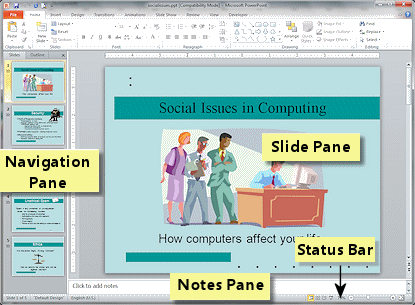 At
the left of the Normal view in PowerPoint.
At
the left of the Normal view in PowerPoint.

 PowerPoint 2007, 2010: Navigation Pane has
two tabs: Slides and Outline. You can do some of your editing
tasks directly in the Outline or with the Slides thumbnails.
PowerPoint 2007, 2010: Navigation Pane has
two tabs: Slides and Outline. You can do some of your editing
tasks directly in the Outline or with the Slides thumbnails.

 PowerPoint 2013, 2016: No tabs but the Outline View appears in the same place, but wider. Outline View opens with the Outline View button on the View ribbon tab.
PowerPoint 2013, 2016: No tabs but the Outline View appears in the same place, but wider. Outline View opens with the Outline View button on the View ribbon tab.
- network printer
- A printer that is connected directly to a network instead of being connected to a computer.
- Notes page
-
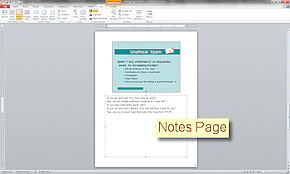 A
view which shows a slide and its notes on a single page for
printing.
A
view which shows a slide and its notes on a single page for
printing.
- Notes Pane
- A small pane at the bottom of the Normal view in which you can write notes to yourself or to be printed on handouts.
O
- Open (an object)
- Command used to change to Edit Mode for an embedded or linked object.
- Options dialog
-
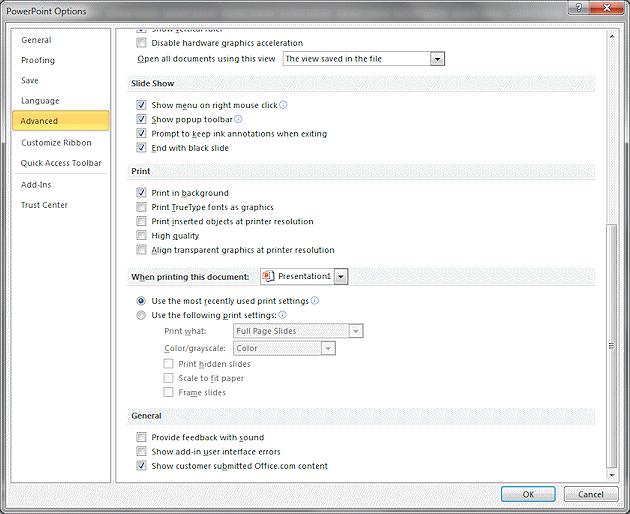 A
dialog which contains settings that control how PowerPoint
behaves.
A
dialog which contains settings that control how PowerPoint
behaves.
- orientation
- The paper we normally print on is rectangular, so you have the
choice of printing in Landscape (horizontal) orientation
 or in Portrait (vertical) orientation
or in Portrait (vertical) orientation .
.
- outline
-
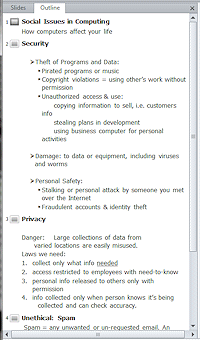 An
outline arranges the thoughts in your document in a hierarchy
order where the most important points are at the same outline
level and the supporting points are at a lower level. In a
PowerPoint presentation, the slide titles are at the highest level
in the outline. The bullet points fall in levels below, based on
their indentions.
An
outline arranges the thoughts in your document in a hierarchy
order where the most important points are at the same outline
level and the supporting points are at a lower level. In a
PowerPoint presentation, the slide titles are at the highest level
in the outline. The bullet points fall in levels below, based on
their indentions.
- outline levels
- The hierarchy levels in an outline.
P
- Package for CD
- To combine files and fonts with one or more presentations for burning onto a CD or saving to a removable drive for transport to a different computer.
- page layout
- The arrangement on a paper page for printing. PowerPoint offers layouts with 1 to 9 slides on a page for handouts, a note page layout, and the default layout of each slide taking up a whole sheet of paper.
- Page Setup dialog
-
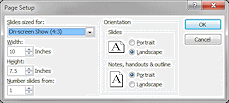 The
PowerPoint Page Setup dialog offers fewer choices than in many
other programs. You can choose the orientation of slides and
print-outs but not the page margins. The Slides sized for: box has
several choices, which affect the proportions of your slides.
The
PowerPoint Page Setup dialog offers fewer choices than in many
other programs. You can choose the orientation of slides and
print-outs but not the page margins. The Slides sized for: box has
several choices, which affect the proportions of your slides.
- pane
-
 A
section of the program window. PowerPoint in Normal view has 3
panes: Navigation which shows either the outline or thumbnails of
the slides, Slide, and Notes. Other panes are available at times, like the Office Clipboard, Selection, and Animation.
A
section of the program window. PowerPoint in Normal view has 3
panes: Navigation which shows either the outline or thumbnails of
the slides, Slide, and Notes. Other panes are available at times, like the Office Clipboard, Selection, and Animation.
- paragraph styles
- Assigns formatting characteristics to a paragraph and may assign an outline level.
- Paste Options
-
 The
Paste Options button
The
Paste Options button
 appears just after you paste, near where you
pasted. It is easy to overlook! Clicking the down arrow opens a list of options.
appears just after you paste, near where you
pasted. It is easy to overlook! Clicking the down arrow opens a list of options.
- pixilated
- An image which was resized and now shows splotches and
jagged edges where each pixel was enlarged
- placeholder
-
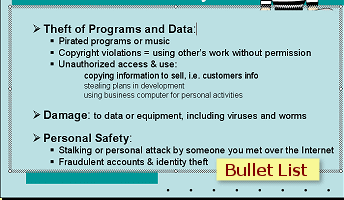 A
placeholder is a text box whose text will appear in the Outline.
You cannot create a placeholder or change an ordinary text box
into a placeholder. You must use the placeholders from a
PowerPoint slide layout. You can move or resize a placeholder. The
illustration at the right shows a bullet list placeholder.
A
placeholder is a text box whose text will appear in the Outline.
You cannot create a placeholder or change an ordinary text box
into a placeholder. You must use the placeholders from a
PowerPoint slide layout. You can move or resize a placeholder. The
illustration at the right shows a bullet list placeholder.
- Play button
- A button which causes the Slide Pane to run the animations and transitions of the displayed slide
- .ppt
- File extension for PowerPoint presentations, versions 2003 and earlier.
- .pptx
- File extension for PowerPoint presentations, versions 2007, 2010, and 2013.
- presentation
- A set of slides for use on-screen or in printed handouts, primarily to accompany a speaker.
- presentation graphics
- Another term for presentation software.
-
 Print dialog
Print dialog - A dialog for controlling how your presentation prints.
- Printer Properties dialog
-
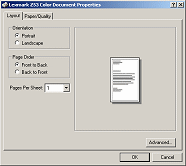 Varies
with the brand and model of your printer. Controls the printer's
hardware choices - print quality, color, media.
Varies
with the brand and model of your printer. Controls the printer's
hardware choices - print quality, color, media.
- Print Preview
- View of a presentation that shows what will print.
- Print Preview toolbar
- In PowerPoint 2007, a toolbar appears at the top of the window with buttons and other controls about printing.
-

- print quality
- Usually you can choose from at least Draft, Normal, and Best. Better quality means smoother lines and smoother transitions in gradient backgrounds.
- For some printers you can choose the dots per inch (dpi). The more dots, the higher quality the printing.
- Print what: box
-
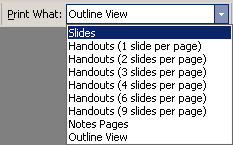 A control where you can choose how you want the presentation printed - slides or handout or notes or outline. If you want to print the slides, you can choose how many to put on a page.
A control where you can choose how you want the presentation printed - slides or handout or notes or outline. If you want to print the slides, you can choose how many to put on a page. - promote
- To raise a paragraph to a higher outline level
- Protected View
- Allows you to view in a safe way a file that was downloaded from the Internet or that appears to be risky in some way. You cannot edit or print while in Protected View. A gold warning bar appears below the ribbon when such a file opens. The bar includes a button, Enable Editing, which turns off the protection.
Q
- Quick Access Toolbar
 A toolbar at the top left of the window which holds command buttons for easy access.
A toolbar at the top left of the window which holds command buttons for easy access.
R
- recolor
- To change the colors in a clip art image
- Rehearse timings
- To step through a slide show and record the number of seconds between changes.
- Ribbon
- The area under the Title bar that holds ribbon tabs, which
hold buttons and other controls.

- Rich Text Format
- A text format that includes basic formatting, like font, font size, bold, and italics.
- row
- A horizontal set of cells in a table.
- row label
- A cell at the left end of a row in a table that contains text that tells what that data is, like a product name or a location or the item sold.
S
- shared printer
- A printer that can accept print jobs from computers besides the one to which it is connected.
- slide
- in computing: one of a set of images to be shown on a monitor or projected onto a screen. Part of a presentation.
- in photography: a 35 mm transparency for projecting onto a screen using a slide projector.
- slide layout
- The arrangement of placeholders on the slide
- slide show
- Displays the slides on the monitor as they will be shown on a screen
- Smart Tag
-
 A
feature of Microsoft Office programs that produces buttons with
context-sensitive menus directly over the document being edited.
Different Office programs use different Smart Tags/Actions in
addition to some other 'smart' buttons. PowerPoint 2007, 2010, and 2013
have Paste Options, AutoCorrect Options, and AutoFit Options.
A
feature of Microsoft Office programs that produces buttons with
context-sensitive menus directly over the document being edited.
Different Office programs use different Smart Tags/Actions in
addition to some other 'smart' buttons. PowerPoint 2007, 2010, and 2013
have Paste Options, AutoCorrect Options, and AutoFit Options.
- Status Bar
- A bar at the bottom of the window which has areas that tell you of the current status of the program.
-

T
- tab
- A portion of the Ribbon which has a set of related controls
and commands. The illustration shows the Home tab for PowerPoint
2010.

- tab group
- A section of a ribbon tab that holds related controls and
commands. The illustration below shows the Presentation Views
and Master Views tab groups on the View ribbon tab.

- table
- A set of rows and columns
- Task Pane
-
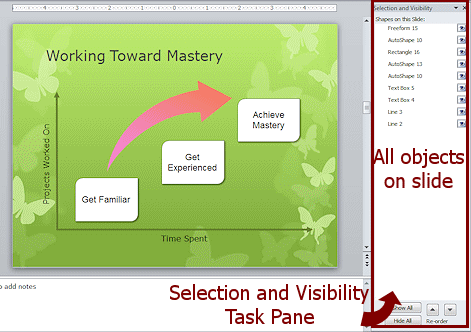 Appears at the right or
left of the
window and offers choices for doing a task, such as creating a new
document or inserting clipart.
Appears at the right or
left of the
window and offers choices for doing a task, such as creating a new
document or inserting clipart.
- template
- A file that already has a set of formatting choices and slide layouts, along with temporary text that guides you in what to say (at least a little bit).
- text document
- A document with plain text, virtually no formatting.
- text table
- Creating the effect of a table by lining up text using tabs and spaces.
- theme
- A collections of design choices for background, fonts, effects, and slide masters.
- thumbnail
- A small image of a larger image or document
- timings
- The set of time intervals between changes in a presentation.
- toggle
- To alternate between two settings, such as On/Off or Active/Inactive, usually by clicking the same button or command in a menu again.
- transition
- An effect that controls how the next slide comes into view.
- transparency
- in presentations: a transparent plastic sheet used with an overhead projector to display on a screen the text or images on the transparency
- in photography: a 35 mm transparency for projecting onto a screen using a slide projector
U
V
- vector image
- An image that is made of calculated parts. Resizing a vector image does not lose any of its quality.
- view
- A combination of window parts that work well together for a task
- View: Masters
- The Masters views show the masters for slides in a presentation or handouts or notes pages. You set the default placeholders and formatting for a presentation on the masters.
-
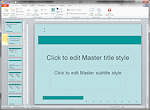
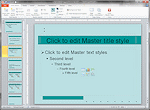
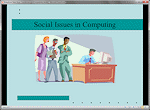
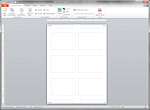
- View: Normal
- The Normal view includes the Slide pane, Navigation pane, and Notes pane.
-
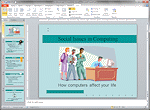
- View: Notes
- The Notes View shows the slides, one per page, with their notes below.
-
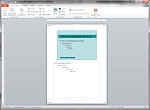
- View: Print Preview
- The Print Preview view shows how the slides will print. There are several layouts to choose from.
-
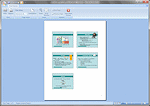
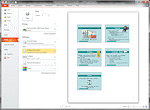
- View: Reading
- The Reading view runs the slide show inside the PowerPoint
window instead of full screen.

- View: Slide Show
- The Slide Show opens the presentation full screen so you can see how your audience will see the slides.
-
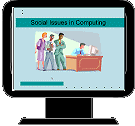
- View: Slide Sorter
- In Slide Sorter view you see rows of thumbnails of all the slides. You can drag the slides to new locations or delete them.
-
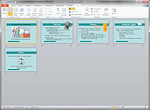
- Views Bar
-
 A bar at the bottom of the Navigation Pane. The buttons switch
you to a different view. The Views Bar buttons vary depending on your version of
PowerPoint.
A bar at the bottom of the Navigation Pane. The buttons switch
you to a different view. The Views Bar buttons vary depending on your version of
PowerPoint. - virtual printer
- Not an actual physical device. Examples include fax software, which sends a fax instead of printing, and PDF software, which creates a file in PDF format. A virtual printer might send data from a document directly to another program, like OneNote.
